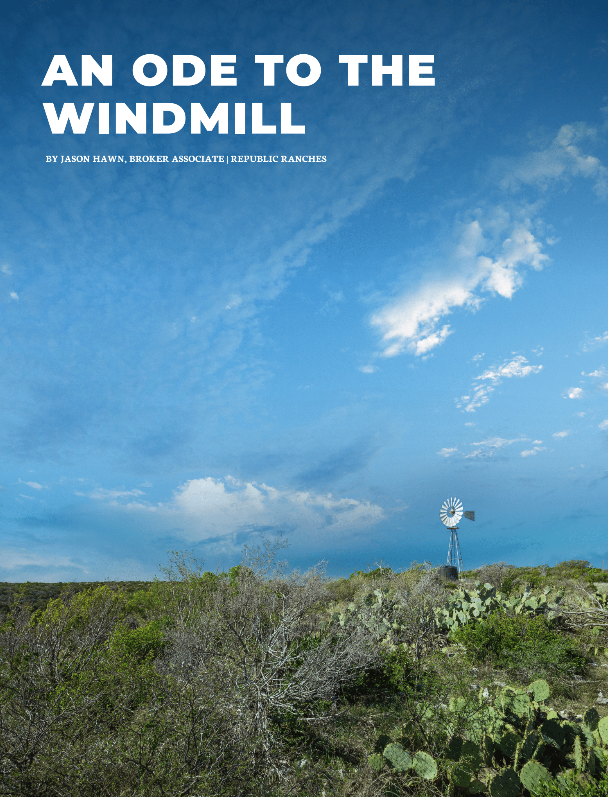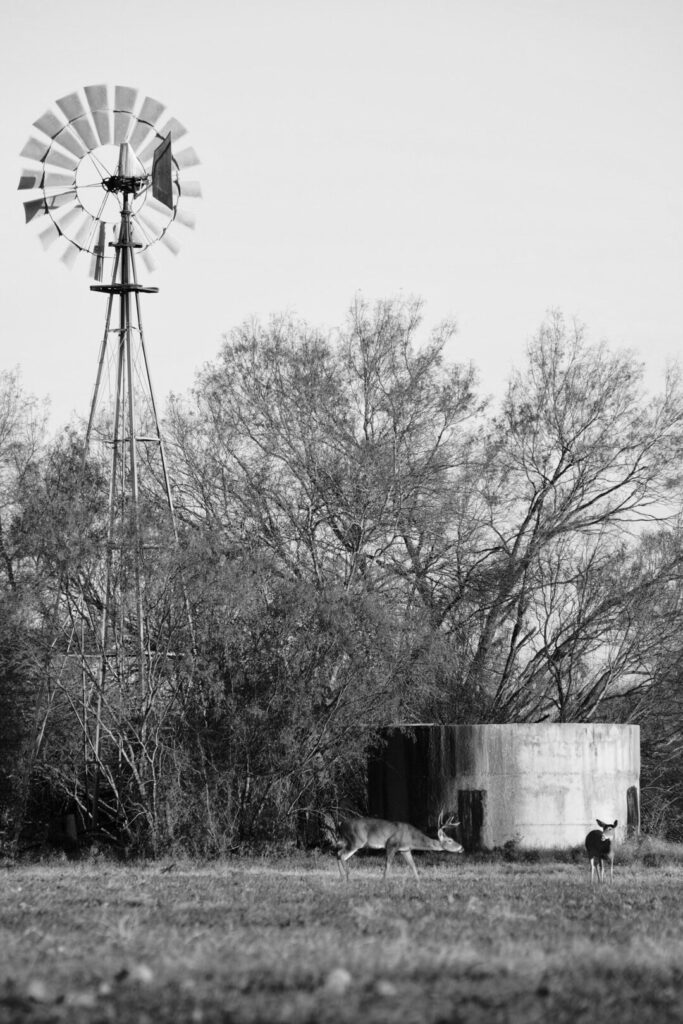By: Jason Hawn, Broker Associate, Republic Ranches, Featured in Land Investor Magazine Volume 8

I am sentimental by nature, and especially so when it comes to Texas and ranching. To me, there isn’t anything more iconic than an expanse of prairie with nothing more than an old windmill on the horizon. We all know this image, and, if you are even the least bit sentimental or nostalgic, it will surely tug at your heartstrings.
Water pump windmills have been a staple and, frankly, the lifeblood of ranchers, livestock, and cowboys, for almost two hundred years. However, in the past thirty years, technological advancements and competitive costs for solar wells have made even the most old-school landowners wonder whether the time of the windmill may have passed.
Speaking with sixth-generation rancher, Augie McCan, whose family has been ranching for one hundred forty years in the central coastal region of Texas under the umbrella of McFaddin Enterprises, the cost savings are so great with solar wells that he can no longer justify maintaining the ranch’s thirty plus windmills. Prior to Hurricane Harvey, McFaddin Enterprises maintained over seventy windmills. The storm destroyed almost half of the ranch’s windmills, which have all been converted to solar. Five years out from the devastating hurricane, all of the upgraded wells are producing, with very minimal maintenance required, and have proven to be a sound investment.
While anecdotal, this story reflects the decisions many ranches grappling with higher costs across the board are making. Due to their mechanical nature, windmills inherently need more maintenance. Leathers need to be replaced every two to five years, gears need oiling, sucker rods will rust or wear out, parts to repair are either twenty to thirty feet in the air, or down in the well, to name a few of the most common (and potentially costly) necessary repairs.
Most of us, while not experts on windmills, have a basic understanding of how they work. Since solar pumps utilize modern technology rather than rudimentary mechanics, I think understanding how solar pumps work helps take some of the mystery out of the technology. It’s as simple as this: Solar cells within solar panels absorb photons from the sun and convert them into DC electricity. An inverter converts DC electricity to AC (alternating current) electricity. This electricity is used to operate the water pump. An added option is installing deep-cycle batteries that use the solar power to maintain a charge, and will operate the pump when the cells aren’t producing (such as at night, or during stormy weather).

Solar-powered water pumps have very few mechanical parts, which lessens the chances of components needing repairs. They can last for many years without requiring maintenance. In fact, good quality solar cells have warranties for up to twenty-five years, and the inverters normally are warrantied for six to eight years.
Normally, just as with a traditional windmill, water will be piped into a trough, holding tank, or pond to supplement when water isn’t being pumped. Solar wells also have the added benefit of pump controllers to regulate the water pump, and allow it to be turned on and off. They can increase the life of the water pump by protecting it from electrical irregularities or motor damage if it keeps running when a water source runs dry. Controllers also maximize water delivery.
Obviously, there are practical considerations when deciding between a traditional windmill versus a solar water pump. What is the average length of daylight, the average amount of wind? Is there a reputable company in your area to service your installation?
I’m purposely not going into a deep dive on the costs of each system. Generally, initial setup for a solar pump is comparable to the setup for a wind pump, and costs for solar go down when you take in the cost of ongoing maintenance over the life of the well. But, there are a lot of options for windmills and solar panels alike, and different areas may require specialized equipment. Furthermore, you must consider how much output you require, and the depth of your local water table, which can change the economics of which system is best suited for you. Most outfits that have traditionally installed and serviced windmills have become proficient in the installation and maintenance of solar pumps, so you should be able to work with a local provider who can design and price a custom solution, and compare the two options. Beyond that, it’s a question of what system best meets your personal budget and goals — and how sentimental you are.